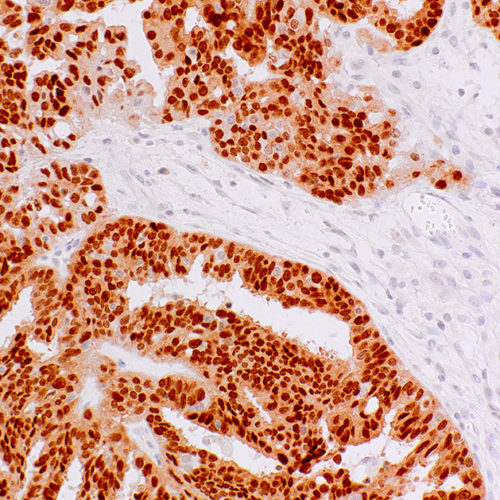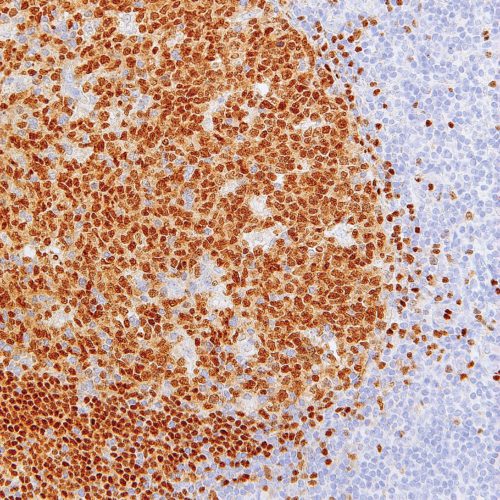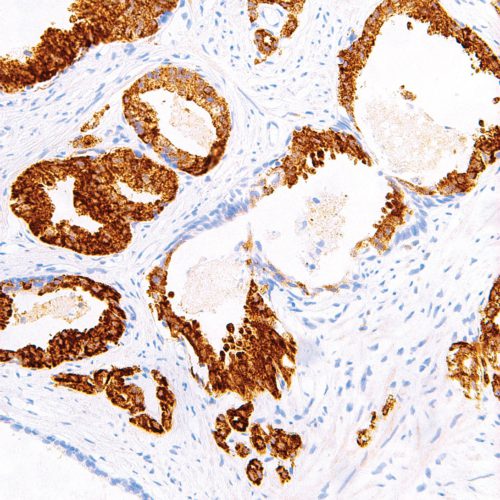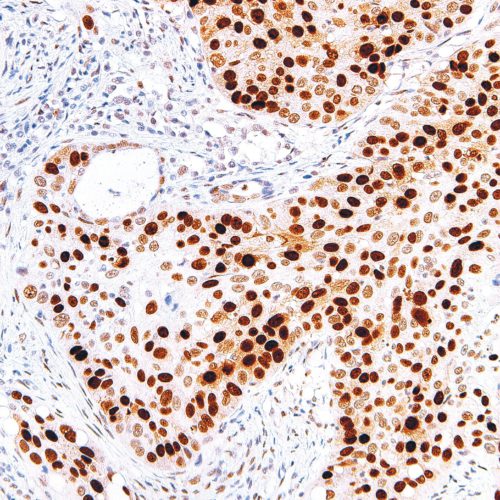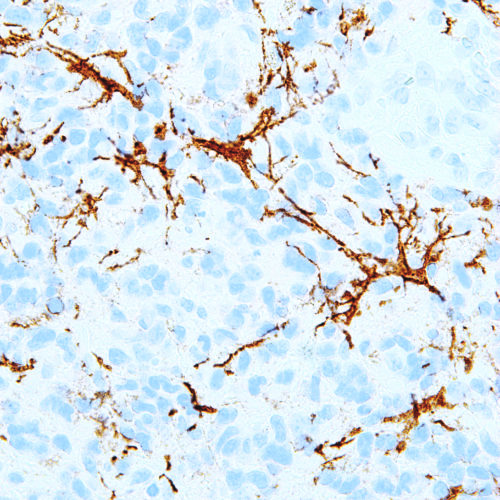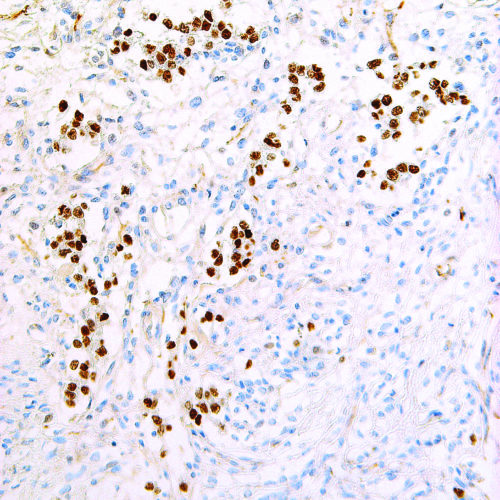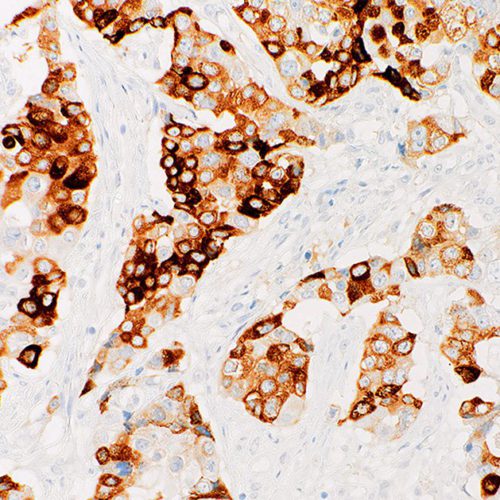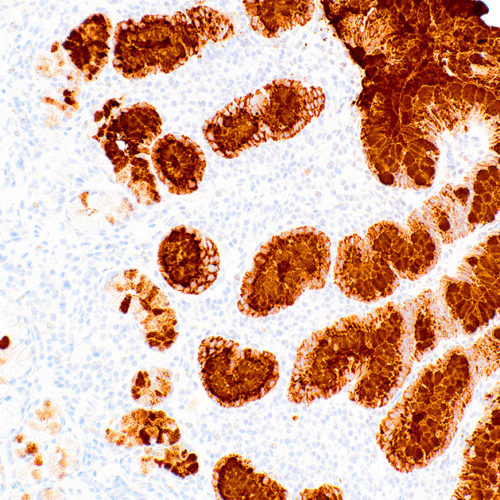High quality products to support Pathologists and Biological and Environmental Scientists
GeneAb™ PAX-8
$150.00 – $780.00PAX-8 is a member of the paired box (PAX) family of transcription factors, which are key regulators in early development. This protein plays a role in development of thyroid follicular cells and the expression of thyroid-specific genes, with mutations in the PAX-8 gene linked to thyroid follicular carcinomas, atypical thyroid adenomas, and thyroid dysgenesis. The PAX-8 protein is expressed in simple ovarian inclusion cysts and non-ciliated mucosal cells of the fallopian tubes, but is absent from normal ovarian surface epithelial cells. PAX-8 is also not expressed in normal lung or lung carcinomas. Reports have associated PAX-8 expression with renal carcinoma, nephroblastoma, and seminoma, and have indicated PAX-8 as a useful marker for renal epithelial tumors, ovarian cancer, and for differential diagnoses in lung and neck tumors. Anti-PAX-8 can be useful in determining the primary site of invasive micropapillary carcinomas of ovary from bladder, lung, and breast, when used in adjunct with a panel of organ-specific markers such as uroplakin, mammaglobin, and TTF-1.
GeneAb™ PAX-5
$50.00 – $255.00PAX-5 is a member of the paired box (PAX) family of transcription factors, which are key regulators in early development. The PAX-5 gene encodes the B-cell lineage specific activator protein (BSAP), whose expression is limited to early stages of B-cell differentiation. Anti-PAX-5 is useful in differentiating between classic Hodgkin’s lymphoma versus multiple myeloma and solitary plasmacytoma, as the protein is expressed in mature and precursor B-cell non-Hodgkin’s lymphomas/leukemias while being absent from the other two conditions. Diffuse large B-cell lymphomas are positive for PAX-5, with the exception of those with terminal B-cell differentiation, and T-cell neoplasms do not stain with Anti-PAX-5.
GeneAb™ p504s
$80.00 – $285.00p504s, also known as α-methylacyl coenzyme A racemase (AMACR), is an enzyme localized in the peroxisome and mitochondria, which functions in β-oxidation of branched chain fatty acids, as well as bile synthesis. AMACR has been clinically indicated as a tissue biomarker for prostate cancer and colorectal cancer, as well as high-grade prostatic intraepithelial neoplasia, a precursor lesion of prostate cancer. p504s overexpression has also been detected in a number of other cancers including ovarian, breast, bladder, lung, and renal cell carcinomas, lymphoma, and melanoma.
GeneAb™ p53
$70.00 – $280.00p53, also known as tumor protein 53 or TP53, is a tumor suppressor and transcription factor that functions in a number of anti-cancer activities including DNA repair, cell-cycle arrest, and apoptosis in response to DNA damage or other stressors. Mutations in p53 are linked to a number of malignant tumors, including those of the breast, ovarian, bladder, colon, lung, and melanoma. Anti-p53 staining has been used to detect intratubular germ cell neoplasia, and also to distinguish between uterine serous carcinoma and endometrioid carcinoma.
GeneAb™ Nerve Growth Factor Receptor (NGFR)
$115.00 – $520.00Nerve Growth Factor Receptor (NGFR), also known as p75, P-75NTR or CD271, is a neurotrophin receptor belonging to the tumor necrosis factor receptor family. NGFR is expressed mainly in Schwann cells and neurons, as well as a number of other non-neuronal cell types, and functions during central and peripheral nervous system development to regulate neuronal growth, migration, differentiation, and cell death. Nerve Growth Factor Receptor is also expressed in melanocytes, melanomas, neuroblastomas, pheochromocytomas, neurofibromas, neurotized nevi (type C melanocytes), and other neural crest cell or tumor derivatives. It has been suggested that NGFR may act as a tumor suppressor indicated in prostate and urothelial cancer, and Anti-Nerve Growth Factor Receptor (NGFR) is often used in adjunct with S100, to aid in the diagnosis of desmoplastic and neurotrophic malignant melanomas. Anti-NGFR is also useful as an aid in the diagnosis of breast malignancy, as the antibody labels the myoepithelial cells of breast ducts and intralobular fibroblasts of breast ducts.
GeneAb™ Nanog
$100.00 – $405.00Nanog is a homeoprotein that functions with pluripotent factors such as Oct4 and Sox2 to maintain embryonic stem cell pluripotency. Expression of this protein has been noted in seminoma, dysgerminoma, embryonal carcinoma, and other undifferentiated germ cell tumors, while nanog expression is absent in normal adult organ tissues. Anti-Nanog may be useful in distinguishing between undifferentiated germ cell tumors and non-germ cell tumors.
GeneAb™ MUC6
$75.00 – $280.00Mucin 6 (MUC6) is a glycoprotein expressed in mucous neck cells, pyloric glands of the antrum, epigastric and bronchial epithelium, and in Müller ducts of the endocervix and urethral epithelium. Anti-MUC6 is useful for differentiating fetal, precancerous, and cancerous colonic mucosa from normal colon, as the antibody does not stain the latter. Anti-MUC6 stains the gastric epithelial surface of normal human gastrointestinal tract.
GeneAb™ MUC5AC
$75.00 – $300.00Mucin 5AC (MUC5AC) is a secretory-type mucin found in columnar mucous cells of surface gastric epithelium and in goblet cells of the fetal and precancerous colon, but not in normal colon cells. MUC5AC expression is indicated in carcinomas wherein the type is defined as diffuse and infiltrative, and those located mainly in the antrum. Studies have also suggested a correlation between MUC5AC and colorectal signet-ring cell carcinoma, with overexpression of MUC5AC relating to the carcinogenesis, malignant potential, progression, and clinical behaviors.
